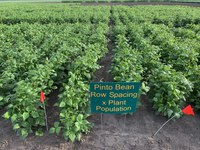Dry Beans Respond to Row Spacing and Plant Population
(Click the image below to view a high-resolution image that can be downloaded)
Narrower row spacings and higher plant populations are trending in dry bean production, says Greg Endres, North Dakota State University Extension cropping systems specialist based at NDSU’s Carrington Research Extension Center.
NDSU has been conducting field research during the past decade to examine the response of black, navy and pinto beans to selected combinations of row spacings and plant populations to identify optimum seed yield.
The research was conducted during 2014 to 2018 in eastern North Dakota with black and navy beans grown in reduced row spacing and with increased plant populations, compared with wide rows (28 to 30 inches) and the standard 90,000 plants/acre. Researchers found:
- Black bean seed yield averaged across four trials was similar among three row spacings of 14, 21 and 28 inches. Averaged across eight trials, yield increased slightly (less than 100 pounds per acre) with just fewer than 120,000 or 140,000 plants per acre, compared with yield with an average of slightly fewer than 100,000 plants per acre.
- Narrow (14-inch) rows with navy bean plant populations of 117,000 or 140,000 plants per acre increased yield 24% to 28%, respectively, compared with wide rows with slightly more than 90,000 plants per acre.
More information about this research is available in the NDSU Extension publication “Black and Navy Bean Response to Row Spacing and Plant Population in Eastern North Dakota.” It’s available online at https://tinyurl.com/BlackandNavyBeans. A printed version is available from the Carrington Research Extension Center or NDSU Extension county offices.
“Similar research work currently is in progress with pinto beans,” Endres says. “We are examining seed yield response with narrow rows and selected plant populations, compared with NDSU’s long-term recommendation of establishing 70,000 pinto bean plants per acre in wide rows.”
The average pinto bean seed yield among four trials conducted in eastern North Dakota with 18-inch rows was 11% and 16% greater versus 12- and 30-inch rows, respectively. In a series of five trials conducted at Carrington, pinto bean yield increased 18% with intermediate row spacing (21 to 22 inches), compared with wider rows.
Averaged across four pinto bean trials at Carrington and Minot, N.D., a plant population of slightly more than 70,000 plants per acre had a yield advantage of 6%, compared with 53,000 plants per acre. Preliminary results with intermediate row spacing and plant populations near 90,000 plants per acre are indicating yield and economic advantages, compared with wide rows and the standard plant population.
The research with the three dry bean market types has been supported by the NDSU Agricultural Experiment Station and Northarvest Bean Growers Association.
Visit https://www.ag.ndsu.edu/publications/crops/dry-bean-production-guide for a newly revised NDSU Extension guide on general recommendations for dry bean production.
NDSU Agriculture Communication - April 22, 2020
| Source: | Greg Endres, 701-652-2951, gregory.endres@ndsu.edu |
|---|---|
| Editor: | Ellen Crawford, 701-231-5391, ellen.crawford@ndsu.edu |


